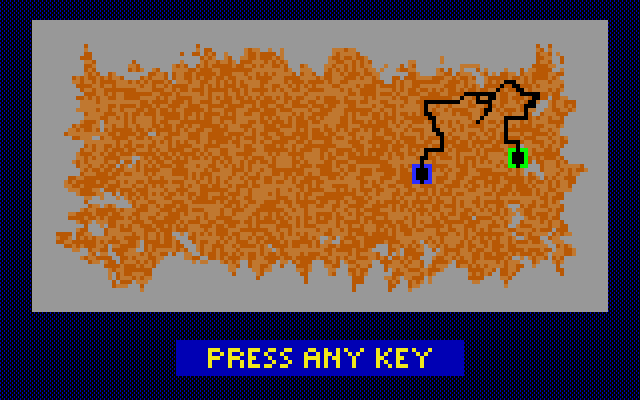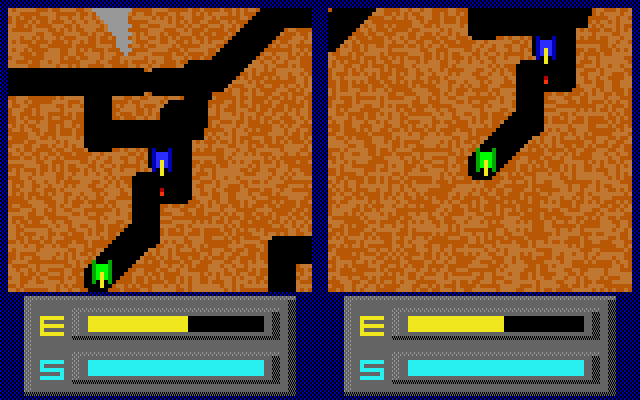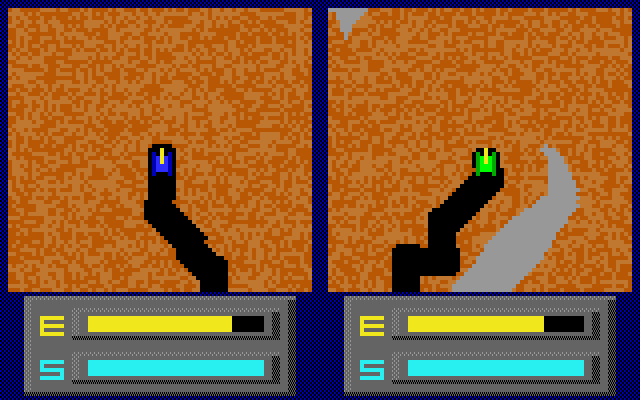Retro Replay Review
Gameplay
Tunneler delivers a deceptively simple premise that hides a surprisingly deep strategic core. Players start in separate, randomly generated underground arenas, armed only with a tank and an explosive shell. The primary objective is straightforward: locate and destroy your opponent before they do the same to you. However, the challenge comes from the vast, maze-like network of tunnels that each player must carve out by blasting through dirt.
(HEY YOU!! We hope you enjoy! We try not to run ads. So basically, this is a very expensive hobby running this site. Please consider joining us for updates, forums, and more. Network w/ us to make some cash or friends while retro gaming, and you can win some free retro games for posting. Okay, carry on 👍)
The split-screen presentation adds a layer of tension, as both you and your rival can observe each other’s progress in real time. This transparency encourages bait-and-switch tactics—one player can feign retreat or create false tunnels to lure the other into a trap. Meanwhile, creating dead ends and switchbacks becomes a vital defensive maneuver. These simple mechanics foster a cat-and-mouse experience that keeps matches intriguing, even after multiple rounds.
Another compelling aspect is the tension of the final discovery. As soon as you break into your opponent’s network, both players are alerted. You must make rapid decisions about which tunnel path to follow, while your adversary gleefully watches from the split-screen. The pressure to choose correctly elevates each encounter into a nerve-wracking duel that rewards both quick thinking and careful planning.
Graphics
Visually, Tunneler embraces the aesthetic of early 1980s computer games. The color palette is limited—mostly earth tones for the dirt and contrasting bright colors for the tanks and shells. While this might seem austere by modern standards, the graphical simplicity is part of the game’s charm. The clear, blocky visuals ensure that players can instantly distinguish between solid terrain, open tunnels, and enemy projectiles.
The split-screen design keeps both action zones visible at all times, providing a comprehensive overview of each player’s tunneling progress. Despite the low resolution, the differentiation between various tunnel paths is clear, so there’s no confusion about where you have been or where you’re going. The minimalistic interface also means there’s no HUD clutter—just two mazes, two tanks, and an unspoken race to victory.
While there are no flashy animations or particle effects, the crisp, responsive display ensures every tunnel dug and every shell fired feels immediate. The retro visual style serves the gameplay rather than distract from it, resulting in a pure arcade experience that remains accessible and engaging decades after its release.
Story
Tunneler does not present a traditional narrative; instead, it relies on emergent storytelling born from each match’s unique tunnel layouts and tactical encounters. Every game generates a new underground labyrinth, making each duel feel like a fresh adventure. The ‘story’ emerges organically as you lay traps, execute ambushes, and mount desperate retreats, all under the constant pressure of your opponent’s gaze on the split-screen.
Players often create their own lore around memorable battles: that one epic chase through a spiraling tunnel, the moment you narrowly avoid an ambush, or the clever feint that sends your opponent careening into a dead end. These personal anecdotes form the heart of Tunneler’s narrative appeal. In the absence of cutscenes or dialogue, it’s the shared experiences—and the bragging rights that come with victory—that give the game its lasting appeal.
For those looking for a story-driven campaign with character development and plot twists, Tunneler may feel sparse. Yet, for fans of improvisational play and competitive spirit, its sandbox of subterranean warfare provides a richer storyline than any canned script. The unspoken rivalry and ever-shifting tunnels become the stage for countless tales of triumph and narrow escapes.
Overall Experience
Playing Tunneler today is akin to stepping into a time capsule of early multiplayer gaming. Its bare-bones presentation and simple mechanics belie the excitement of its head-to-head matches. Every session is a blend of exploration, strategy, and split-second decision-making that can keep two players glued to the screen for repeated rematches.
The game’s strength lies in its purity: two opponents, a maze to conquer, and the thrill of discovering—or being discovered. While there’s no in-depth progression system or unlockable content, the procedural nature of the tunnels ensures high replayability. Each duel unfolds unpredictably, with victory often hinging on both tactical ingenuity and split-second reactions.
Ultimately, Tunneler is best suited for gamers who appreciate retro simplicity, local competitive play, and a sandbox approach to conflict. It lacks modern frills, but what it offers in return is an undiluted, adrenaline-fueled battle of wits beneath the surface. For those seeking a quick yet enduring multiplayer challenge, Tunneler remains a subterranean classic worth digging into.
 Retro Replay Retro Replay gaming reviews, news, emulation, geek stuff and more!
Retro Replay Retro Replay gaming reviews, news, emulation, geek stuff and more!








Reviews
There are no reviews yet.